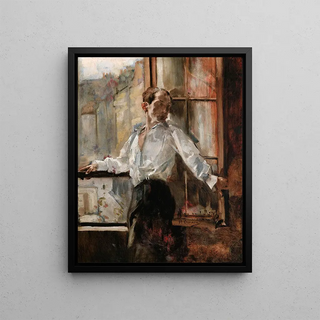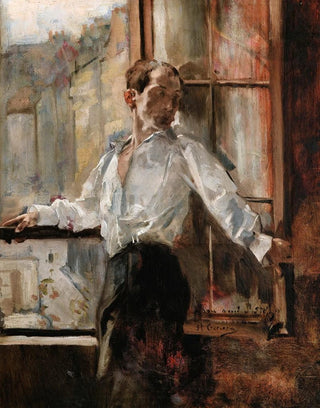Art print | Rolla - Henri Gervex


View from behind

Frame (optional)
In the fascinating world of art, some artworks manage to capture the very essence of their era while transcending the boundaries of time. "Rolla" by Henri Gervex, painted in 1884, is one of those creations that invites contemplation and reflection. This iconic piece, depicting a moment of intimacy between a woman and a man, resonates with palpable sensuality and psychological depth that leave no one indifferent. Through its play of light and delicate colors, Gervex evokes an atmosphere both charged with desire and melancholy, transporting the viewer into a universe where every detail tells a story.
Style and uniqueness of the artwork
Gervex's style is distinguished by his bold approach to realism and symbolism, blending elements of everyday life with a touch of dream. In "Rolla," the composition is carefully orchestrated, each element taking its place with a precision that testifies to the artist's remarkable talent. The woman, portrayed with delicate grace, is dressed in a sumptuous gown that seems to almost float around her, while the man, whose face is partially hidden, adds a dimension of mystery to the scene. The nuances of colors, ranging from warm tones to cooler shades, create a striking contrast that emphasizes the emotional intensity of the piece. This painting does not merely depict a scene; it invites the viewer to question human relationships, unfulfilled desires, and the unspoken truths that inhabit each interaction.
The artist and his influence
Henri Gervex, born in 1852, was a French painter who established himself in the artistic circles of his time. A student of the École des Beaux-Arts in Paris, he was influenced by the great masters of the 19th century, while developing a style that is uniquely his own. His work aligns with the lineage of artists who sought to represent beauty in all its forms, while striving to capture the essence of modern life. Gervex was also an active participant in the Impressionist movement, although his approach is distinguished by

Matte finish

View from behind

Frame (optional)
In the fascinating world of art, some artworks manage to capture the very essence of their era while transcending the boundaries of time. "Rolla" by Henri Gervex, painted in 1884, is one of those creations that invites contemplation and reflection. This iconic piece, depicting a moment of intimacy between a woman and a man, resonates with palpable sensuality and psychological depth that leave no one indifferent. Through its play of light and delicate colors, Gervex evokes an atmosphere both charged with desire and melancholy, transporting the viewer into a universe where every detail tells a story.
Style and uniqueness of the artwork
Gervex's style is distinguished by his bold approach to realism and symbolism, blending elements of everyday life with a touch of dream. In "Rolla," the composition is carefully orchestrated, each element taking its place with a precision that testifies to the artist's remarkable talent. The woman, portrayed with delicate grace, is dressed in a sumptuous gown that seems to almost float around her, while the man, whose face is partially hidden, adds a dimension of mystery to the scene. The nuances of colors, ranging from warm tones to cooler shades, create a striking contrast that emphasizes the emotional intensity of the piece. This painting does not merely depict a scene; it invites the viewer to question human relationships, unfulfilled desires, and the unspoken truths that inhabit each interaction.
The artist and his influence
Henri Gervex, born in 1852, was a French painter who established himself in the artistic circles of his time. A student of the École des Beaux-Arts in Paris, he was influenced by the great masters of the 19th century, while developing a style that is uniquely his own. His work aligns with the lineage of artists who sought to represent beauty in all its forms, while striving to capture the essence of modern life. Gervex was also an active participant in the Impressionist movement, although his approach is distinguished by






